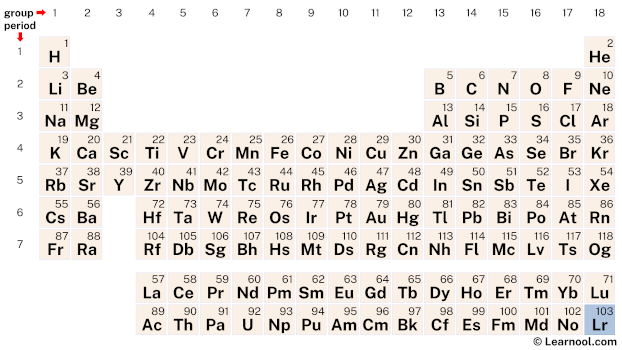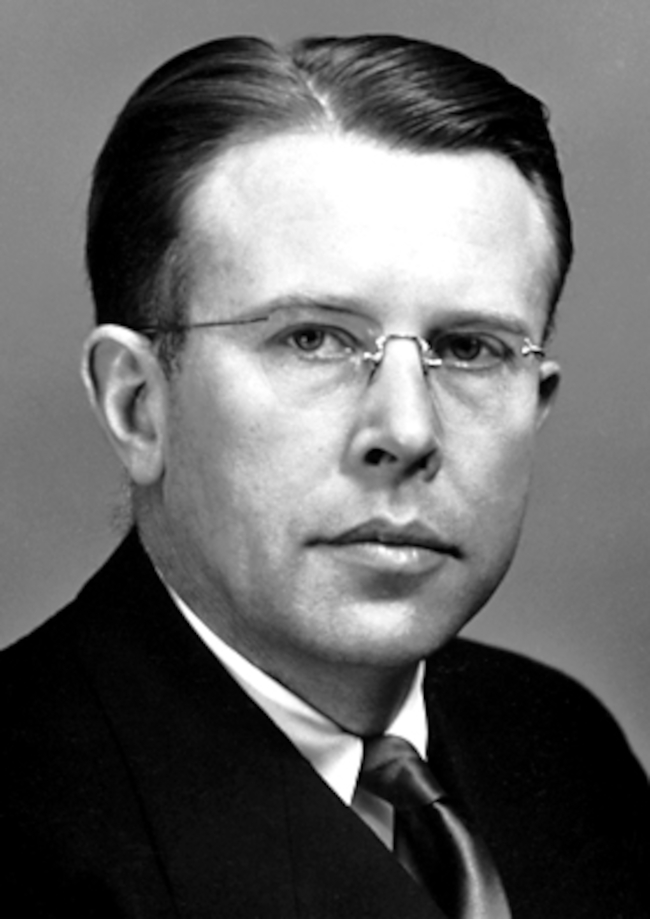
Lawrencium (Lr) is a chemical element of the periodic table, located in the group 3 and the period 7, and has the atomic number 103. It is the last element in the actinide series. It is a silvery-white metal which is named after the American scientist Ernest O. Lawrence, inventor of the cyclotron. It is the eleventh transuranium element and is counted as one of the radioactive elements.
On periodic table
| group | ⇨ | 1 | 2 | 3 | 4 | 5 | 6 | 7 | 8 | 9 | 10 | 11 | 12 | 13 | 14 | 15 | 16 | 17 | 18 |
| period | ⇩ | ||||||||||||||||||
| 1 | 1 H  Hydrogen |
2 He  Helium |
|||||||||||||||||
| 2 | 3 Li  Lithium |
4 Be  Beryllium |
5 B  Boron |
6 C  Carbon |
7 N  Nitrogen |
8 O  Oxygen |
9 F  Fluorine |
10 Ne  Neon |
|||||||||||
| 3 | 11 Na  Sodium |
12 Mg  Magnesium |
13 Al  Aluminium |
14 Si Silicon |
15 P  Phosphorus |
16 S  Sulfur |
17 Cl  Chlorine |
18 Ar  Argon |
|||||||||||
| 4 | 19 K  Potassium |
20 Ca  Calcium |
21 Sc  Scandium |
22 Ti  Titanium |
23 V  Vanadium |
24 Cr  Chromium |
25 Mn  Manganese |
26 Fe  Iron |
27 Co  Cobalt |
28 Ni  Nickel |
29 Cu  Copper |
30 Zn  Zinc |
31 Ga  Gallium |
32 Ge  Germanium |
33 As  Arsenic |
34 Se  Selenium |
35 Br  Bromine |
36 Kr  Krypton |
|
| 5 | 37 Rb  Rubidium |
38 Sr  Strontium |
39 Y  Yttrium |
40 Zr  Zirconium |
41 Nb  Niobium |
42 Mo  Molybdenum |
43 Tc  Technetium |
44 Ru  Ruthenium |
45 Rh  Rhodium |
46 Pd  Palladium |
47 Ag  Silver |
48 Cd  Cadmium |
49 In  Indium |
50 Sn  Tin |
51 Sb  Antimony |
52 Te  Tellurium |
53 I  Iodine |
54 Xe  Xenon |
|
| 6 | 55 Cs  Caesium |
56 Ba  Barium |
72 Hf  Hafnium |
73 Ta  Tantalum |
74 W  Tungsten |
75 Re  Rhenium |
76 Os  Osmium |
77 Ir  Iridium |
78 Pt  Platinum |
79 Au  Gold |
80 Hg  Mercury |
81 Tl  Thallium |
82 Pb  Lead |
83 Bi  Bismuth |
84 Po  Polonium |
85 At  Astatine |
86 Rn  Radon |
||
| 7 | 87 Fr  Francium |
88 Ra  Radium |
104 Rf  Rutherfordium |
105 Db  Dubnium |
106 Sg  Seaborgium |
107 Bh  Bohrium |
108 Hs  Hassium |
109 Mt  Meitnerium |
110 Ds  Darmstadtium |
111 Rg  Roentgenium |
112 Cn  Copernicium |
113 Nh  Nihonium |
114 Fl  Flerovium |
115 Mc  Moscovium |
116 Lv  Livermorium |
117 Ts  Tennessine |
118 Og  Oganesson |
||
| 57 La  Lanthanum |
58 Ce  Cerium |
59 Pr  Praseodymium |
60 Nd  Neodymium |
61 Pm  Promethium |
62 Sm  Samarium |
63 Eu  Europium |
64 Gd  Gadolinium |
65 Tb  Terbium |
66 Dy  Dysprosium |
67 Ho  Holmium |
68 Er  Erbium |
69 Tm  Thulium |
70 Yb  Ytterbium |
71 Lu  Lutetium |
|||||
| 89 Ac  Actinium |
90 Th  Thorium |
91 Pa  Protactinium |
92 U  Uranium |
93 Np  Neptunium |
94 Pu  Plutonium |
95 Am  Americium |
96 Cm  Curium |
97 Bk  Berkelium |
98 Cf  Californium |
99 Es  Einsteinium |
100 Fm  Fermium |
101 Md  Mendelevium |
102 No  Nobelium |
103 Lr Lawrencium |
|||||
| – d block |
Lawrencium is found in the actinide series, a group of elements located at the bottom of the periodic table. Specifically, in period 7, next to nobelium (No).
Element information
 |
|
| Origin of name | named after American scientist Ernest O. Lawrence |
| Symbol | Lr |
| Atomic number (Z) | 103 |
| Atomic mass | (262) |
| Block | d-block |
| Group | 3 |
| Period | 7 |
| Classification | Lanthanide |
| Melting point | 1627 ℃, 2961 ℉, 1900 K (predicted) |
| Electron configuration | [Rn] 5f14 7s2 7p1 |
| Electrons per shell | 2, 8, 18, 32, 32, 8, 3 |
| Crystal structure | Hexagonal close-packed (hcp) (predicted) |
| Phase at r.t | Solid (predicted) |
| Natural occurrence | Synthetic |
| Oxidation state | +3 |
| Electronegativity (Pauling scale) | 1.3 (predicted) |
| Protons Neutrons Electrons |
103 159 103 |
| CAS number | 22537-19-5 |
| Discovered at | Lawrence Berkeley National Laboratory and Joint Institute for Nuclear Research in 1961 |
History

Lawrencium was first synthesized in 1961 at the Lawrence Berkeley National Laboratory (LBNL) in California. The element was named after Ernest O. Lawrence, who was the inventor of the cyclotron particle accelerator and a Nobel laureate in physics. The discovery of lawrencium was a collaborative effort between scientists from the LBNL and the Joint Institute for Nuclear Research (JINR) in Dubna, Russia.
The synthesis of lawrencium was achieved through the bombardment of a californium-252 target with boron-10 and boron-11 ions. The first isotope produced was lawrencium-258, which has a half-life of about 4 seconds. The identification of this isotope was confirmed by observing the characteristic decay pattern of its daughter products.
There were initial disputes over the discovery of lawrencium between the LBNL and JINR teams. The LBNL team claimed to have discovered lawrencium before the JINR team, while the JINR team disputed this claim and argued that they had produced the element first. However, both teams eventually agreed to credit each other for the discovery of lawrencium.
Occurrence and production
Lawrencium is a synthetic element and does not occur naturally on Earth. It is produced through nuclear reactions using other elements. Lawrencium can be created by bombarding lighter elements with heavy ions in a particle accelerator. The isotopes of lawrencium have a very short half-life, making it difficult to study their properties.
The production of lawrencium requires a nuclear reactor or particle accelerator. The most common method of producing lawrencium is through bombarding lighter elements with heavy ions in a particle accelerator. One of the most successful methods of producing lawrencium was developed at the Lawrence Berkeley National Laboratory in California, where the element was first synthesized in 1961 by bombarding californium-249 with boron-10 ions.
To produce larger quantities of lawrencium, scientists use a nuclear reactor to irradiate targets made of lighter elements with neutrons. This produces heavier elements, including lawrencium. However, the yields are low, and the resulting isotopes are difficult to isolate and purify.
Due to the short half-life of lawrencium isotopes, only a few atoms of the element have ever been produced, making it one of the rarest and most expensive elements to study. The cost of producing a few atoms of lawrencium can run into millions of dollars.
Properties
Lawrencium is a highly radioactive element and its most stable isotope, lawrencium-262, has a half-life of only 4 hours.
Due to its short half-life, very little is known about the chemical and physical properties of lawrencium. However, it is expected to have properties similar to those of other actinide metals, such as actinium, thorium, and uranium.
Lawrencium is believed to be a silvery-white metal that readily reacts with air, water, and acids.
The element is highly electropositive and has a relatively low melting point and boiling point compared to other actinides.
It is also expected to have a high density and be highly paramagnetic.
Lawrencium is not naturally occurring, so all of its properties are based on experimental observations and theoretical predictions.
Applications
As a highly radioactive element with a short half-life, lawrencium has limited practical applications. However, it is still important in the field of nuclear physics, where it is used to study the behavior of heavy elements and their nuclear reactions.
Here are some specific applications of lawrencium:
Nuclear research
The study of lawrencium and its properties has contributed to our understanding of nuclear physics and the behavior of heavy elements. Its synthesis and study have also helped scientists develop techniques for synthesizing other superheavy elements.
Target for nuclear fusion
Lawrencium can be used as a target material for nuclear fusion experiments, where it can be bombarded with other particles to produce even heavier elements.
Medical applications
Although lawrencium itself does not have any medical applications due to its high radioactivity, its synthesis and study have contributed to the development of medical isotopes for diagnostic imaging and cancer treatment.
Technological applications
Lawrencium does not have any direct technological applications, but its study has helped scientists develop new technologies for synthesizing and studying heavy elements. This has important implications for fields like materials science, where the behavior of heavy elements is important for understanding the properties of advanced materials.
Interesting facts
Lawrencium is a highly radioactive element, with a half-life of only a few hours. This makes it difficult to study and limits its practical applications.
Lawrencium is the last element in the actinide series, which includes elements with atomic numbers from 89 to 103. These elements are all radioactive and have unique properties due to their electron configurations.
Lawrencium is named after Ernest O. Lawrence, the inventor of the cyclotron, which was used to create many synthetic elements. Lawrence was also the founder of the Lawrence Berkeley National Laboratory, where lawrencium was first synthesized.
Lawrencium has no known biological role and is highly toxic due to its radioactivity. It poses a significant health risk to humans and the environment, and must be handled with extreme caution.
Lawrencium has very few practical applications due to its short half-life and high radioactivity. However, it has provided valuable insights into the structure and behavior of heavy elements, as well as contributing to our understanding of nuclear physics.
Lawrencium is one of the rarest elements on Earth, with only a few atoms ever produced in the laboratory. Its high cost and limited availability make it unlikely to have any commercial applications in the foreseeable future.
The discovery of lawrencium was controversial, as there were competing claims from different research groups about who first synthesized the element. The International Union of Pure and Applied Chemistry (IUPAC) ultimately credited the Lawrence Berkeley team with the discovery of lawrencium, based on their extensive work in characterizing the element and its properties.
Lawrencium has the highest atomic number of any element to have been synthesized in measurable quantities. Its discovery was a major milestone in the study of synthetic elements and the periodic table of elements.
Related
More elements
External links
- https://www.rsc.org/periodic-table/element/103/lawrencium
- https://en.wikipedia.org/wiki/Lawrencium
- https://www.britannica.com/science/lawrencium
- https://pubchem.ncbi.nlm.nih.gov/element/Lawrencium
- https://www.chemicool.com/elements/lawrencium.html
- https://www.livescience.com/40485-facts-about-lawrencium.html
- https://www.utoledo.edu/nsm/ic/elements/lawrencium.html
Deep
Learnool.com was founded by Deep Rana, who is a mechanical engineer by profession and a blogger by passion. He has a good conceptual knowledge on different educational topics and he provides the same on this website. He loves to learn something new everyday and believes that the best utilization of free time is developing a new skill.
